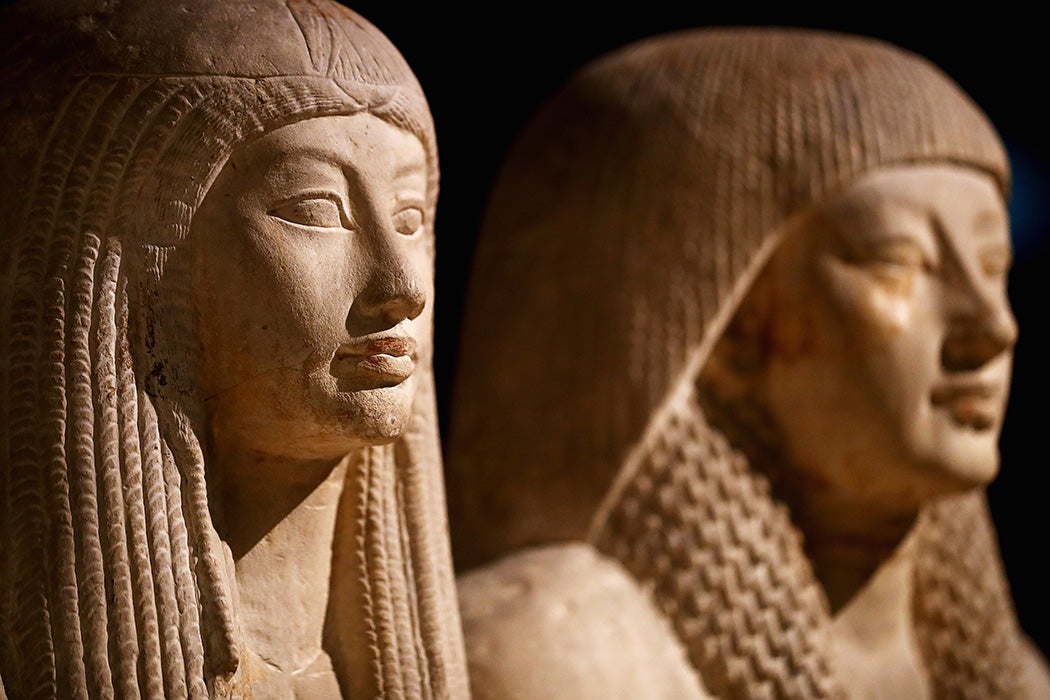Human hair provides an excellent canvas for self-expression, but not everyone can be very flexible in their choice of hairstyle. That was true in ancient Egypt, where depictions of hair reflected social status and idealized identities of men, women, and children.
Art historian Gay Robins looks at how Egyptian tomb chapels built between about 1480 and 1350 BCE depicted stratification by gender, status, and age in the form of hair. The chapels were commissioned by “high-ranking male officials” to show idealized versions of their family. In iconography, both men and women wore wigs. Underneath them, women kept long hair and men almost invariably wore it “short or shaven.” In contrast, non-elites working outside the home were often shown with their natural locks.
Tomb chapels depicted prepubescent children as small, nude, sucking their index fingers, and with their heads shaved, “apart from a lock of hair that falls from the right-hand side,” Robins writes. There were not many gender signifiers until boys and girls reached puberty. Then they were shown clothed, with hairstyles “strongly marked for gender.”
Gender, in fact, was greatly important, as was social status. Elite adult men wore wigs above shoulder level, the most distinguished wearing ones “elaborately arranged in strands, curls or braids.” By taking the hair of other people to wear themselves, elite men depicted power “to command” others for their own purposes.
Elite men’s sons were junior in rank to their fathers, both in the family and in the broader society. That lesser status shows up in the chapels, where sons are shown wearing “either a short, round wig or a shaven head.” Less hair could signify subservient status, whether to a god or mortal master, as priests and household servants were shown with shaven heads. When a priest took on a son’s metaphorical role in a rite, he wore a wig with a side lock.
In contrast to men’s shorter locks, both “elite women and female household servants” were distinguished by “long hair falling below the shoulders, often to breast level.” Women wore their own hair long, even beneath wigs, and are shown with short hair mainly in devotional contexts. Robins argues that women’s locks were closely tied to fertility, reinforcing the notion that sexual maturation was the point at which hairstyles for young women diverged from those of young men.
Weekly Newsletter
Women marked other life stages by changing hairstyles or wigs. Robins notes that a particular “tripartite style,” with tresses framing the face and a third group in a ponytail, “marked a particular stage in a young woman’s life, when she was no longer a child but still not married.” The ability to wear such different wigs implies that “women had the leisure to expend on having their hair groomed and the resources to command another’s services for the task.”
As Robins concludes, “Although scenes in tomb chapels were not intended to reproduce exactly the real world, but rather represented an elite ideal, the system of identity constructed in the art must have reflected a corresponding system in life that defined the identity of individuals and their place within society.” Hairstyles show that elite men derived their status and identity from their position “outside the home,” while women constructed their identities on monuments in relation to a man, iconographically and through their status as someone’s daughter, relative, wife.
And that’s not splitting hairs.
Support JSTOR Daily! Join our new membership program on Patreon today.







